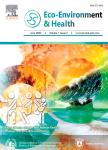Next generation per-and poly-fluoroalkyl substances:Status and trends,aquatic toxicity,and risk assessment
作者机构:Toxicology CenterUniversity of SaskatchewanSaskatoonSaskatchewanS7N 5B3Canada School of Environment and SustainabilityUniversity of SaskatchewanSaskatoonSaskatchewanS7N 5C8Canada Global Institute for Water SecurityUniversity of SaskatchewanSaskatoonSaskatchewanS7N 3H5Canada Centre for HydrologyUniversity of SaskatchewanSaskatoonSaskatchewanS7N 1K2Canada Department of Veterinary Biomedical SciencesUniversity of SaskatchewanSaskatoonSaskatchewanCanada Department of Integrative Biology and Center for Integrative ToxicologyMichigan State UniversityEast LansingMIUSA Department of Environmental ScienceBaylor UniversityWacoTXUSA
出 版 物:《Eco-Environment & Health》 (生态环境与健康(英文))
年 卷 期:2022年第1卷第2期
页 面:117-131页
学科分类:082803[工学-农业生物环境与能源工程] 08[工学] 0828[工学-农业工程]
基 金:was supported by a Discovery Grant(Project#326415-07)from the Natural Sciences and Engineering Research Council of Canada.Prof Giesy was supported by the Canada Research Chair Program,and a Distinguished Visiting Professorship in the Department of Environmental Sciences,Baylor University in Waco,TX,USA.Prof Brinkmann is currently a faculty member of the Global Water Futures(GWF)program,which was funded in part with financial support from the Canada First Research Excellence Funds(CFREF)
主 题:PFAS Replacement PFAS Emerging contaminants Aquatic toxicity Chemical scoring
摘 要:Widespread application of poly-and per-fluoroalkyl substances(PFAS)has resulted in some substances being ubiquitous in environmental *** and their resistance to degradation have allowed them to accumulate in wildlife and humans with potential for toxic *** specific substances of concern have been phased-out or banned,other PFAS that are emerging as alternative substances are still produced and are being released into the *** review focuses on describing three emerging,replacement PFAS:perfluoroethylcyclohexane sulphonate(PFECHS),6:2 chlorinated polyfluoroalkyl ether sulfonate(6:2 Cl-PFAES),and hexafluoropropylene oxide dimer acid(HFPO-DA).By summarizing their physicochemical properties,environmental fate and transport,and toxic potencies in comparison to other PFAS compounds,this review offers insight into the viabilities of these chemicals as replacement *** the chemical scoring and ranking assessment model,the relative hazards,uncertainties,and data gaps for each chemical were quantified and related to perfluorooctane sulfonic acid(PFOS)and perfluorooctanoic acid(PFOA)based on their chemical and uncertainty *** substances were ranked PFOS6:2 Cl-PFAESPFOAHFPO-DAPFECHS according to their potential toxicity and PFECHSHFPO-DA6:2 Cl-PFAESPFOSPFOA according to their need for future *** future uses of PFAS remain uncertain in the face of governmental regulations and production bans,replacement PFAS will continue to emerge on the world market and in the environment,raising concerns about their general lack of information on mechanisms and toxic potencies.




